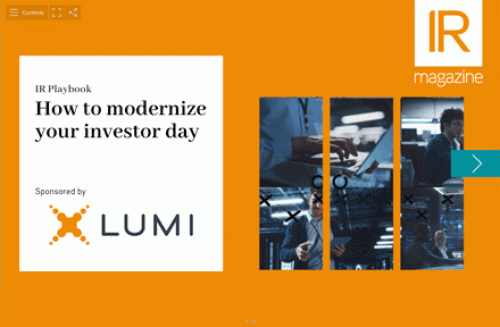A year ago, many of the words likely to define 2023’s IR lexicon didn’t even exist. The rapid emergence of consumer-facing (and business-facing) artificial intelligence tools, the growing target placed on record-breaking stock buybacks juxtaposed with large-scale layoffs and the hyper-politicization of the once-arcane world of ESG are just the latest issues fundamentally reshaping today’s corporate and IR operating environment.
To help navigate the road ahead, I’d like to add just one more idea to the IR lexicon: the four vectors. This one, though, is designed to add order to the chaos. ‘The four vectors’ is a novel framing but it codifies a reality that has faced business throughout modern history. Each vector represents one of four primary drivers of influence facing any business: the state, society, the organization and the capital markets.
‘Stakeholder capitalism an incomplete picture’
The balance of these vectors and each of their respective audiences is sometimes described as ‘stakeholder capitalism’. But that concept paints an incomplete picture. As you know, today’s stakeholder map is intricately multi-dimensional and perpetually in motion. The interplay between and among the vectors is just as critical to recognize as the individual audiences they represent.
These vectors are churning faster, and more powerfully, than ever before. States are generating unpredictable and often incompatible policies you need to understand. Societies are demanding differing concepts of justice, fairness and representation that influence ESG and sustainability messaging. Organizations consist of employees who are seeking more information about the way the company is viewed externally. And all this while capital markets are tapping into unprecedented data and computing power to set their own benchmarks for success – while demanding a clear-cut (and increasingly profit-driven) vision for the future.

Companies in the modern era must navigate through the pushes and pulls of each of these vectors, developing and executing strategies that seek to balance the perceived value for all four, while grappling with the reality that they frequently pull the firm in opposing directions.
States change laws and regulations in part due to society’s demands, while the views of the members of society are significantly shaped by the messages sent from the state’s leadership. Capital markets send daily signals on the perceived value of a particular firm – signals that can cause the state to change its policies and society to alter its behavior. And within the organization, employees and executives evolve their goals and culture based on the inputs of the outside world, while also using the firm’s resources to try to shape the environment to their advantage.
Panic or paralysis
At the center of this turbulent swirl is a company’s core leadership team: the board, CEO and extended C-suite. Many of the biggest headlines for IROs in 2023 have shown that, when caught in the maelstrom of the four vectors, the response is often either public panic (Silicon Valley Bank) or corporate paralysis (Norfolk Southern). Neither projects the type of confidence, clarity and credibility in management that today’s investors demand. And that can fundamentally impact valuation.
So how can today’s IROs help their board, CEO and extended C-suite better navigate today’s corporate operating environment with forward-focused and integrated investor relations strategies – and in doing so, create enduring value for themselves and their company?
Operate across the four vectors
Simply acknowledging the dynamic interplay between capital markets and the state, society and organization will start to shape the way IROs see the world – and their role in it. To maximize their impact, today’s IRO needs to be constantly striving to stay abreast of the legal and regulatory landscape, trends in the public discourse and the evolving expectations employees have for their employers. By operating across the four vectors, IROs can elevate their role and more effectively, meaningfully and impactfully engage with their board and CEO.
Shape insights around the four vectors
That shouldn’t necessarily mean IROs try to do too much. There’s immense value in vector specialization and CEOs will turn to IROs to help inform their decisions with that refined expertise of the capital markets and the investors with which they liaise. By using tools like investor perception studies, they can come to the CEO with more than anecdotes: they can offer hard data and deep, meaningful insights.
To do so, it’s critical that these studies are asking the right questions about what the capital markets expect from the organization in relation to the state and society. The empirical results and insights can then help to better inform organizational strategy, ESG decisions, public policy positions and capital allocation. In this way, the IRO is the single-most important person at the company when it comes to diagnosing whether shareholders believe a company is straying or staying the course.
Engage with the four vectors
Vectored specialization must not translate into vectored silos. IROs should work seamlessly with peers who lead their respective vectors across the firm: legal, compliance and government relations (state); marketing, communications and customer relations (society); and product, strategy and human resources (organization). By maintaining an open and collaborative line of communication across the four vectors, the entire leadership team will significantly improve the strategic decision-making process. Deeper links between these functions will better position and prepare the firm for rapid response in times of crisis, avoiding the panic and paralysis mentioned earlier.
Communicate the four vectors
Finally, IROs can then bring that worldview – and unified corporate vision – to their everyday work: investor relations. As primary communicators to the company’s shareholders, IROs play a unique and critical role in one of the four vectors (capital markets). Meanwhile, all of today’s investor communications are treated like public statements for all of a company’s stakeholders – policymakers (the state), the public (society) and employees (the organization).
Armed with investor perception study insights, IROs can be confident their communications are bespoke to the vector with which they’re charged, without compromising the others’ audiences. In doing so, they can showcase a differentiator worthy of investment: thoughtful and insight-driven strategy that not only meets the moment but also positions the firm to prosper against the test of time.
As capital markets leaders within their company, successful IROs embrace their responsibility to integrate these four vectors into their work and, in doing so, help their CEO maximize the firm’s utility across them. Through the right mindset combined with the right systems and processes, IROs can be confident in the face of 2023’s ever-changing lexicon. And that word – confidence – is one that will yield returns in any market.
Mark Hayes is a partner at Breakwater Strategy










